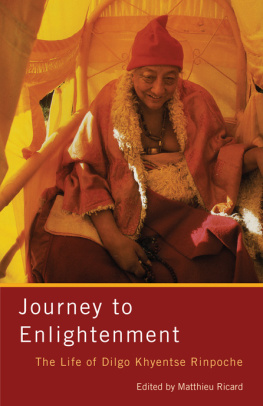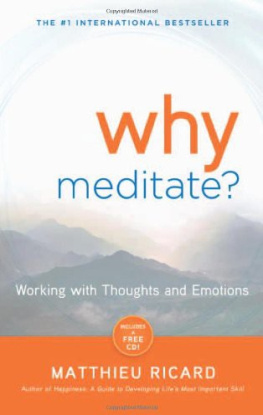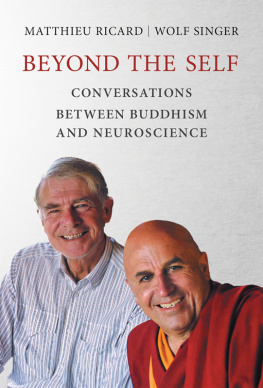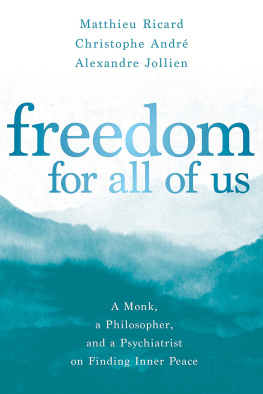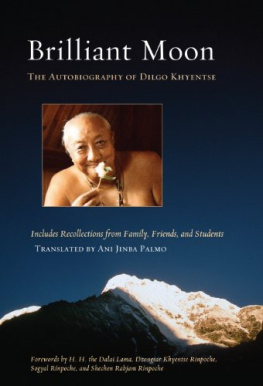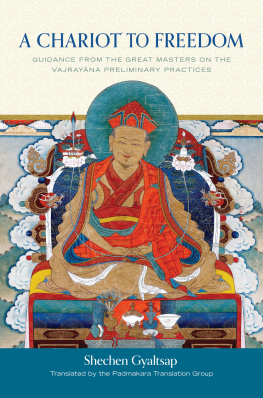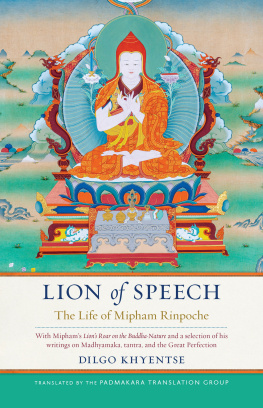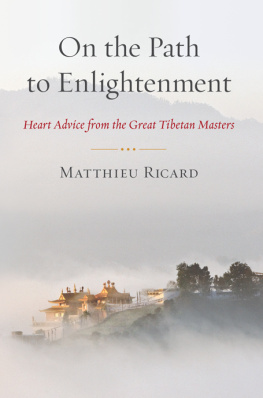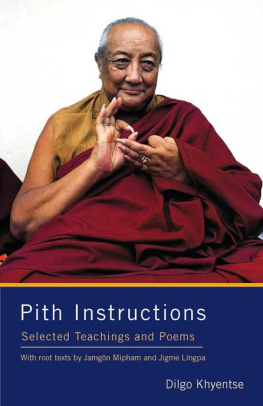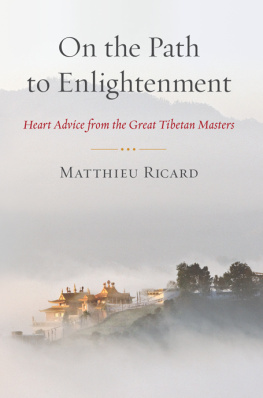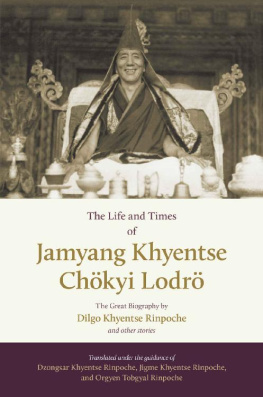Dilgo Khyentse Rinpoche is one of my most revered teachers.... Not only should we admire his inconceivable knowledge, wisdom, and accomplishment, but more important, we should follow his example and emulate those qualities ourselves.
His Holiness the Dalai Lama
ABOUT THE BOOK
An inspiring portrait of one of the great spiritual leaders of the twentieth century, this book follows Dilgo Khyentse Rinpoche in his travels to Tibet, Bhutan, India, and Nepal, revisiting important places from his past. His birthplace in eastern Tibet, the monastery of Shechen that he entered at age eleven, the retreat grounds where he spent years in meditation and studythese are some of the stops along the way. Told in intimate detail by his personal assistant, Matthieu Ricard, this condensed biographical narrative integrates extensive passages from the writings and teachings of the master himself to impart a rare view of his journey to enlightenment.
MATTHIEU RICARD is a Buddhist monk who had a promising career in cellular genetics before leaving France to study Buddhism in the Himalayas. He is a best-selling author, translator, and photographer and an active participant in current scientific research on the effects of meditation on the brain. His many books include Why Meditate?, Happiness: A Guide to Developing Lifes Most Important Skill, and The Quantum and the Lotus. He lives in Nepal and dedicates much of his time to humanitarian projects in the Himalayas through his nonprofit organization Karuna-Shechen. For more information, visit www.matthieuricard.org.
Sign up to receive news and special offers from Shambhala Publications.

Or visit us online to sign up at shambhala.com/eshambhala.
Journey to Enlightenment
The Life of Dilgo Khyentse Rinpoche
Compiled by Matthieu Ricard

Shambhala
Boulder
2015
Shambhala Publications, Inc.
4720 Walnut Street
Boulder, Colorado 80301
www.shambhala.com
Text and photographs 1996 by Shechen Publications
Cover photograph by Matthieu Ricard
This e-book is an abridgment of Journey to Enlightenment: The Life and World of Khyentse Rinpoche, Spiritual Teacher from Tibet (New York: Aperture, 1996). The abridgment was first published in The Collected Works of Dilgo Khyentse, volume 1 (Boston: Shambhala, 2010). See the for more information.
All rights reserved. No part of this book may be reproduced in any form or by any means, electronic or mechanical, including photocopying, recording, or by any information storage and retrieval system, without permission in writing from the publisher.
eISBN 978-0-8348-0282-7
Contents
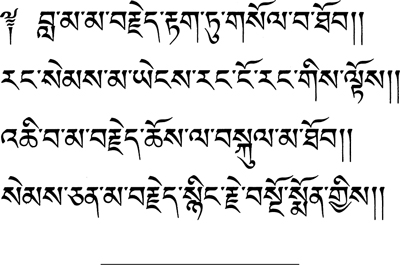
Do not forget the Lama;
Pray to him at all times.
Do not be carried away by thoughts;
Watch the nature of mind.
Do not forget death;
Persist in Dharma.
Do not forget sentient beings;
With compassion dedicate your merit to them.
THIS CONDENSED BIOGRAPHY of Dilgo Khyentse Rinpoche was compiled in the early 1990s from his own written autobiography, interviews with his wife and disciples, and audio recordings in which he recounted various episodes of his life in Tibet. It was written to accompany the photographic account of his life for the book Journey to Enlightenment: The Life and World of Khyentse Rinpoche, Spiritual Teacher from Tibet (New York: Aperture, 1996), reprinted in paperback as The Spirit of Tibet.
In this edition we have supplemented the original text with relevant excerpts and stories from Brilliant Moon, a translation of the complete written autobiography.
The elements of the text were translated from the Tibetan or written and edited by the Padmakara Translation Group, an international group of translators who have practiced and studied Buddhism for several decades under the guidance of eminent Tibetan masters, and is directed by Pema Wangyal Rinpoche and Jigme Khyentse Rinpoche. For this text, the translators were John Canti, Ani Jinba Palmo, Daniel Staffler, and myself. We are very grateful to Erik Pema Kunsang for allowing us to incorporate excerpts from his translation of two oral accounts of Khyentse Rinpoches life by Tulku Orgyen Topgyal.
MATTHIEU RICARD
Shechen Monastery
Nepal
July 2008
FOR MORE THAN A THOUSAND YEARS, Buddhist culture flourished in Tibet as the foundation of a whole society. Monks and nuns accounted for up to a quarter of the population, a figure probably unprecedented in human history. Spiritual practice was clearly the chief goal in life, and laypeople too, men and women, nomads, peasants and traders considered that their day-to-day activities, however necessary, were nevertheless of secondary importance compared to this deeper aspiration.
Such universal commitment to Buddhist practice was without doubt fostered by the very pragmatic way in which Buddhism approached the aim of becoming a better human being, by unraveling the mechanisms of happiness and suffering. It must have been nourished, too, by the dramatic beauty, vastness, and pristine purity of Tibets landscape, which provided an uplifting setting for the contemplative life. Above all, Tibetan Buddhism produced a number of remarkable men and women who, as living examples of perfection, were a constant inspiration to the community.
Typically, the journey of someone disillusioned with materialistic goals starts with the search for a teacher and the growth of confidence in that teacher and his instructions. The student then studies and meditates with great dedication in monasteries or mountain hermitages, or, in the case of householders, at home during the considerable leisure time afforded by Tibets traditional way of life. Some practitioners in their turn eventually become qualified teachers, capable of contributing to the welfare of others. Indeed, the aim of every disciple as he perfects himself is to gain the means with which others can be truly helped.
The Buddhist path is thus rooted in altruism. On a cultural level, this concern for others is expressed as nonviolence toward other people, toward animals, and toward the environment. Tibetans shunned war, hunting, and fishing, and avoided any degradation of their country and its rich natural resources through overexploitation.
All who travel to the Land of Snows or meet refugees outside Tibet are struck by that unique blend of cheerfulness, fortitude, and deeply ingrained confidence in the Buddhist teachings that characterizes the Tibetan people.
In the late 1950s, a sudden blast of sorrow tore through a thousand years of peace as Communist China invaded Tibet. In the 1960s came the Cultural Revolution, and during the twenty years that followed, one million Tibetansa sixth of the populationdied of persecution or starvation. Six thousand monasteries and temples were destroyed. Books were burned or thrown into the rivers. Precious bronze images were melted down and cast into cannons and guns. The genocide was both human and cultural.
Over a hundred thousand Tibetans, led by their spiritual and temporal leader, the fourteenth Dalai Lama, fled to India and other neighboring countries, where they kept alive the flame of freedom and the depth and breadth of Tibetan culture. Many great masters of the four main schools of Tibetan Buddhism continued to teach, and founded new monasteries in the lands of their exile.
Following Mao Tse-tungs death, Tibet underwent a minor degree of liberalization. In 1981, after twenty-five years of complete silence, Tibetan refugees started to receive news from relatives who had stayed in Tibet. Some monasteries were rebuilt, and a limited number of monks were allowed to resume their Buddhist studies and monastic training. A far cry from true freedom, these improvements were nevertheless welcome. A bridge was built between old teachers still alive in Tibet and a younger generation surprisingly eager to study and to join the monasteries. The Chinese realized that decades of persecution had changed nothing of Tibetan attitudes. The regime has since been turning to other methods. Rather than attempting to reform the Tibetans themselves, they now aim at diluting the Tibetan population with a tide of Chinese colonizers to the point of making Tibetans a minority in their own country. Unless quickly reversed, population transfer may very well succeed where persecution failed, and extinguish from our world a unique people and culture.
Next page
